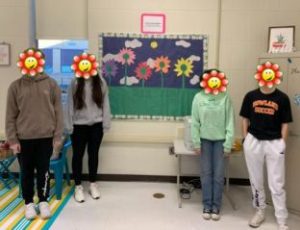When creating lesson plans and activities, one of my goals is to try to incorporate as much movement and hands-on engagement as possible. Not only do students enjoy it, but it seems to pique their interest and gives them a little break from the screens. I love how Shannon Stevens, a FACS teacher from Ohio, does just that in her Interactive Bulletin Boards for Child Development project! Additionally, Shannon wanted to encourage the use of “soft skills” with her students and this project requires student teams to collaborate and communicate with each other as they create and finally provide feedback to other teams after class presentations. While this lesson focuses on child development, the interactive bulletin board concept can be applied in any content area. Read on to learn more…
enjoy it, but it seems to pique their interest and gives them a little break from the screens. I love how Shannon Stevens, a FACS teacher from Ohio, does just that in her Interactive Bulletin Boards for Child Development project! Additionally, Shannon wanted to encourage the use of “soft skills” with her students and this project requires student teams to collaborate and communicate with each other as they create and finally provide feedback to other teams after class presentations. While this lesson focuses on child development, the interactive bulletin board concept can be applied in any content area. Read on to learn more…
Set
- Make sure you are familiar with the concept of interactive bulletin boards and their purpose before starting as this project requires both time and effort which Shannon says is totally worth it! To learn more about interactive bulletin boards, check out this blog.
- This project is assigned after learning about the P.I.E.S from this lesson titled P.I.E.S: The Areas of Development and completing the P.I.E.S: Puzzle Piece Activity.
Materials
- Construction Paper
- Markers
- Scissors
- Glue
- Velcro
- Clothespins
- Stapler
Activities
- Go over the Interactive Bulletin Board Planning Process- Age Group Preschool 3-5 guide sheet with students so they know what the objectives are of the project (see attachments).
- Students are placed in teams.
- Since the bulletin board is changed every month, students sign up for a month ahead of time.
- Teams must brainstorm at least three ideas for their interactive boards. Teams must then discuss and select the idea and theme they will actually create and begin planning and preparing their materials.
- Since these boards are geared to preschool aged children, students must place themselves in the role of the teacher and explain how physical, intellectual, emotional and social learning will take place with the help of Shannon if needed.
- When the time comes, students assemble their board and present it to their peers for evaluation.
- To conclude, student teams reflect on what they have created.
Attachments
- Interactive Bulletin Board Planning Process (please make a copy by going to file and then clicking make a copy in order to edit)
- Bulletin Board Peer Evaluation & Team Reflection (please make a copy by going to file and then clicking make a copy in order to edit)

